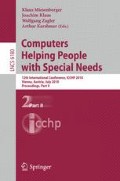Abstract
This paper describes the development of a 3D continuous sign language recognition system. Since many systems like WebSign[1], Vsigns[2] and eSign[3] are using Web3D standards to generate 3D signing avatars, 3D signed sentences are becoming common. Hidden Markov Models is the most used method to recognize sign language from video-based scenes, but in our case, since we are dealing with well formatted 3D scenes based on H-anim and X3D standards, Hidden Markov Models (HMM) is a too costly double stochastic process. We present a novel approach for sign language recognition using Longest Common Subsequence method. Our recognition experiments were based on a 500 signs lexicon and reach 99 % of accuracy.
Access this chapter
Tax calculation will be finalised at checkout
Purchases are for personal use only
Preview
Unable to display preview. Download preview PDF.
References
Jemni, M., Elghoul, O.: Towards Web-Based automatic interpretation of written text to Sign Language. In: ICTA 2007, Hammamet, Tunisia, April 2007, pp. 12–14 (2007)
Papadogiorgaki, M., Grammalidis, N., Makris, L., Sarris, N., Strintzis, M.G.: Vsign Project. Communication (September 20, 2002), http://vsign.nl/EN/vsignEN.htm
Ehrhardt, U., Davies, B.: A good introduction to the work of the eSIGN project. eSIGN Deliverable D7-2 (August 2004)
Cuxac, C.: La LSF, les voies de l’iconicité. Ophrys editions, Paris (2000)
Web3D consortium website, http://www.web3d.org
Humanoid Animation Standard Group, Specification for a Standard Humanoid: H-Anim 1.1, http://www.h-anim.org/Specifications/H-Anim1.1/
Brutzman, D., Ardly, L.: X3D Extensible 3D Graphics for Web Authors. Elsevier, Amsterdam (2007)
Vogler, C., Metaxas, D.: Adapting hidden Markov models for ASL recognition by using three-dimensional computer vision methods. In: IEEE International Conference on Computational Cybernetics and Simulation, Oralando, FL (October 1997)
Starner, T., Weaver, J., Pentland, A.: Real-time American Sign Language Recognition using desk and wearable Computer based Video. J. IEEE Transactions on Pattern Analysis and Machine Intelligence (1998)
Rabiner, L.: A tutorial on Hidden Markov Models and Selected Applications in Speech Recognition. Proc. Of the IEEE 77, 257–289 (1989)
Euclidean Space by Martin John Baker, http://www.euclideanspace.com/maths/geometry/rotations/conversions/quaternionToEuler/
Bergroth, L., Hakonen, H., Raita, T.: A Survey of Longest Common Subsequence Algorithms. J. SPIRE, 39–48 (2000)
Torgeson, W.S.: Multidimensional scaling of similarity. J. Psychometrika 379–393 (2006)
Deza, M., Deza, E.: Dictionary of Distances, Elsevier editions, Amsterdam (2006)
Jaballah, K., Jemni, M.: Automatic Sign Language Recognition using X3D/VRML Animated Humanoids. In: CVHI 2009, Wroclaw, Poland (April 2009)
Author information
Authors and Affiliations
Editor information
Editors and Affiliations
Rights and permissions
Copyright information
© 2010 Springer-Verlag Berlin Heidelberg
About this paper
Cite this paper
Jaballah, K., Jemni, M. (2010). Toward Automatic Sign Language Recognition from Web3D Based Scenes. In: Miesenberger, K., Klaus, J., Zagler, W., Karshmer, A. (eds) Computers Helping People with Special Needs. ICCHP 2010. Lecture Notes in Computer Science, vol 6180. Springer, Berlin, Heidelberg. https://doi.org/10.1007/978-3-642-14100-3_31
Download citation
DOI: https://doi.org/10.1007/978-3-642-14100-3_31
Publisher Name: Springer, Berlin, Heidelberg
Print ISBN: 978-3-642-14099-0
Online ISBN: 978-3-642-14100-3
eBook Packages: Computer ScienceComputer Science (R0)

